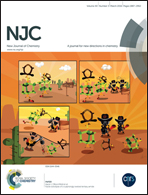Novel VO2(M)–ZnO heterostructured dandelions with combined thermochromic and photocatalytic properties for application in smart coatings†
Abstract
Hierarchical VO2(M)–ZnO dandelions with ZnO nanorods grown radially on VO2(M) nanoparticle cores have been successfully fabricated for the first time. In these dandelions, the VO2(M) NPs were prepared by a TiO2 seed-assisted hydrothermal method and the dandelion-like ZnO nanorods were formed over two steps: heteroseed-induced nucleation and the subsequent heteroepitaxial growth processes. The coupled ZnO could increase the chemical stability of VO2(M) at relatively high temperatures. In addition, the VO2(M)–ZnO composite film with decreased phase transition temperature (Tc = 62.6 °C) simultaneously displayed an enhanced visible transmission (Tvis-l = 52.2%) and solar modulating ability (ΔTsol = 9.3%) as compared with the pure VO2(M) film. Besides, the VO2(M)–ZnO dandelions also exhibited improved photocatalytic performance, likely due to the synergistic effect of the VO2(M)–ZnO heterojunction, unique dandelion-like hierarchical structure and high specific surface area. This is the first report of such a single VO2(M)–ZnO dandelions structure with energy saving and environmental protection effects that offer significant potential for creating a multifunctional smart coating.


 Please wait while we load your content...
Please wait while we load your content...